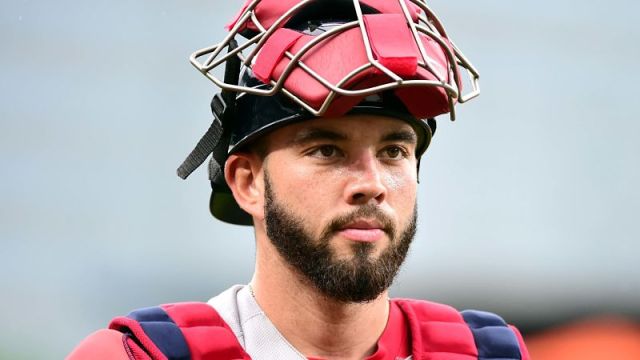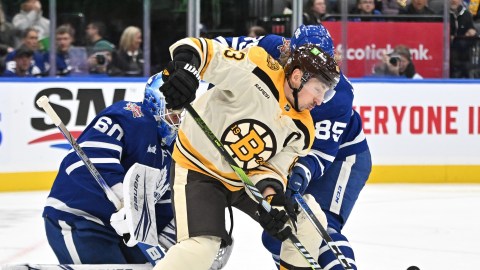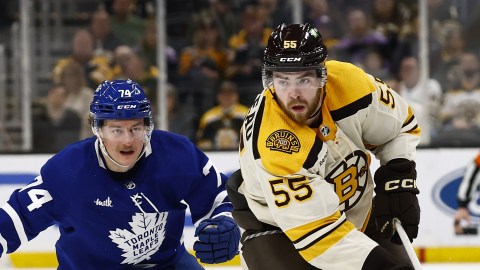The Bruins climbed out of an early hole, winning the second game of their playoff series against the Maple Leafs after Toronto secured the first game in Boston.
On Monday night, the B’s tumbled right back into the hole.
The Leafs grabbed a 2-1 lead in the best-of-seven set with a 3-2 victory in Game 3 at Scotiabank Arena. All five of the game’s goals came in the second period.
The Bruins and Maple Leafs will square off again Wednesday night in Toronto before the series shifts back to Boston for Game 5 on Friday. In the meantime, let’s run down some takeaways from Game 3.
1. Where is the Bruins’ top line?
The Brad Marchand-Patrice Bergeron-David Pastrnak line has been arguably the NHL’s best unit in recent years, but it’s been uncharacteristically absent in this series. The trio has produced only one 5-on-5 goal, with Pastrnak, who’s yet to tickle the twine, looking especially out of sorts.
So, what gives?
Well, first of all, hats off to the Zach Hyman-John Tavares-Mitch Marner line, which — combined with the defensive pairing of Jake Muzzin and Nikita Zaitsev — has found the perfect formula for shutting down Boston’s stars. The Bruins’ top line might break out at some point, but the Maple Leafs’ strong resistance has been the biggest indication yet that this year’s playoff series is far different than last year’s series, which Boston won in seven games.
“They’re essentially man-on-man all over the ice,” Marchand said after Game 3, according to Sportnet.ca. “They don’t play with it in their zone. They throw it out and go after it, so it’s a little tougher to get zone time on them, and most of the time you have a guy in your face.”
Bruce Cassidy sounded committed to keeping Boston’s top line intact despite another underwhelming performance Monday night, but the Bruins coach has shown a willingness in the past to tweak his rotations in search of a spark. Perhaps he’ll consider bumping Pastrnak down to the second line alongside David Krejci and Jake DeBrusk, elevating Danton Heinen to the first line and moving Karson Kuhlman to the third line. Or perhaps he’ll consider more sweeping changes, especially with Charlie Coyle playing so well and Marcus Johansson an option after missing the first two games with an illness.
Whatever the solution (or attempted solution), the point still stands: The Marchand-Bergeron-Pastrnak troika hasn’t given the Bruins the one distinct advantage they typically have over every team with which they share the ice.
2. Charlie Coyle has been a stud
Coyle, acquired from the Minnesota Wild in February, was bit snakebitten down the stretch, totaling just two goals and four assists in 21 games with Boston. He still contributed in other areas, though, and finally is seeing his hard work reflected on the stat sheet, scoring a goal in each of the past two games.
In theory, Cassidy could move Coyle to the second line, on Krejci’s wing, in the hopes of capitalizing on the Weymouth, Mass., native’s energy and recent production. But the Bruins would run the risk of screwing with one thing that’s working in this series, as Heinen and David Backes have looked good on the third line with Coyle centering.
All in all, maybe trading Ryan Donato and a fifth-round pick for Coyle wasn’t such a bad idea. Coyle has been Boston’s best player in this series thus far.
3. Stick tap to the goaltenders
Tuukka Rask and Frederik Andersen both were excellent in Game 3, with each surrendering just one even-strength goal. Rask kept the Bruins in the contest as they tried to mount a comeback, and Andersen helped ice the game in the third period.
Andersen’s third-period poke check on Krejci all but sealed the deal.
This was a continuation of what already had been established, as Rask and Andersen outplayed their stat lines in Games 1 and 2, respectively. Several goals have been due to untidy play in other areas, and one could make the case Andersen has been Toronto’s most consistent player in this series.
4. Boston’s sloppy special teams
The Maple Leafs went 2-for-3 on the power play in Game 3 after being blanked on three chances in Game 2. Toronto didn’t score a power-play goal in Game 1, but Marner scored via a penalty shot after being sprung on a breakaway when the Leafs were shorthanded.
Boston’s penalty kill needs to be better, simply put. The Maple Leafs are getting too many good chances with the man advantage thanks to messy play by the Bruins in their own zone and in the neutral zone.
The special teams problems don’t stop there, either. Boston’s power play hasn’t been all that explosive despite the Bruins scoring one goal in each game with the man advantage. The B’s struggled to gain entry into the Leafs’ zone at several points in Game 3.
“Our kill wasn’t good enough for whatever reason. We talked about it. We were a little late on one, didn’t get it cleared on the other,” Cassidy told reporters after Boston’s 3-2 loss. “Our power play, our first group was a little off. A little of out sync in their plays. I thought we had a really good chance in the third. We got the play we wanted, backdoor to Jake (DeBrusk) and for whatever reason, he wasn’t ready for it. He got knocked off stride. But, giving up two (power-play goals) most nights is a recipe for what happened tonight, a one-goal loss.”
5. Did Auston Matthews just wake up?
Matthews scored a career-high 40 goals as a rookie in 2016-17. He tallied 34 goals in 62 games last season and 37 goals in 68 games this season. The playoffs, however, have been a different story, with Matthews receiving ample blame last year after Boston took down Toronto in seven games.
Matthews entered Monday’s Game 3 with just two points (one goal, one assist) in nine career playoff games against the Bruins, but he potted a power-play goal and added an assist in the second period to help the Maple Leafs seize control.
“He’s a proud guy and wants to be good every night, wants to score, loves to score.” Maple Leafs coach Mike Babcock said of Matthews. “It was great because it relieved a lot of pressure off of him.”
It’s scary to think how good Toronto could be moving forward if Matthews finally plays up to his skill level on the second line alongside Andreas Johnsson and Kasperi Kapanen, as we all know what the Hyman-Taveras-Marner line is capable of offensively and defensively.
6. The Maple Leafs learned how to close
The Leafs now are 38-0-1 including the regular season and postseason when leading after two periods. They’re 24-3-2 when leading after one period.
This is an improvement upon last season, when the Leafs went 31-3-2 during the regular season when leading after two periods but more notably collapsed in the third period of Toronto’s Game 7 loss to Boston. The B’s outscored the Leafs 4-0 in the third period of Game 7 at TD Garden last season after trailing 4-3 through the first 40 minutes.






